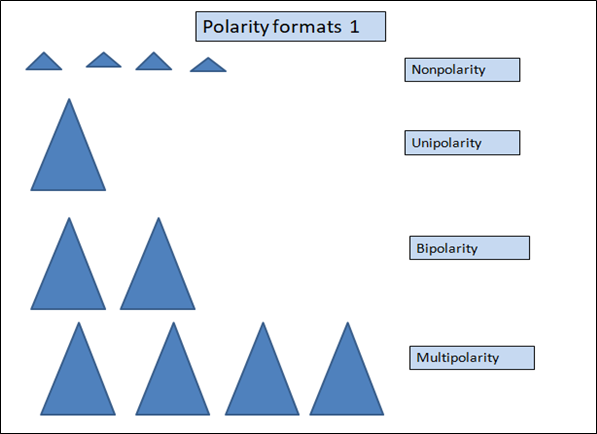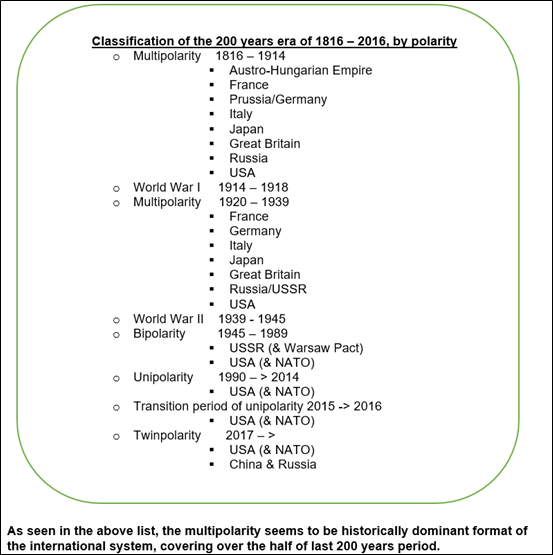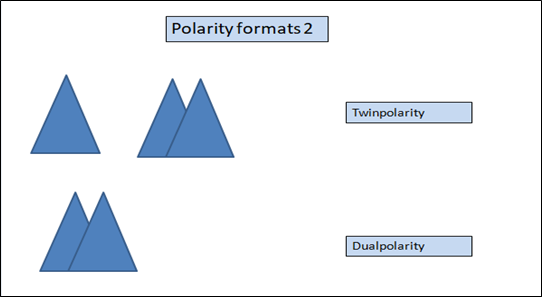Issue of polarity
Waltz’s structural realism or neorealism forms the base for the concept of polarity, which can be define as the structural doctrine accounting for the variations in the power concentrations of anarchically organized context.
Polarity – number of power and decision centers
Waltz’s structural realism or neorealism forms the base for the concept of polarity, which can be define as the structural doctrine accounting for the variations in the power concentrations of anarchically organized context. The paradigm of the international system refers to a certain, specified, prevailing structure of the international system. Paradigm shifts in the systemic structure form significant contextual framework for all research in the international sphere, polarity and stability being the main elements.
Polarity refers to the number of power and decision centers in an international system. The polarity concept is an essential part of the theory of structural realism, which has been previously presented on this website. The number of great powers determines the structure of the international system. Because military power is the ultima ratio of international politics, great powers must possess military capabilities on a par with the most powerful state(s) in the system.
These systemic power concentration points and polarity formulations have been under intensive mathematical and statistical modeling and formulation work since David J. Singer’s initiating project “Correlates of War” 1963. Numerous think tanks and analytical centers calculate and publish various rankings regarding the polarity of international system.
Measuring the power concentration (the systemic concentration of power formula) and national capabilities (composite index of national capabilities, CINC-index) are the two famous concepts, invented by David J. Singer. Theoretically the following polarities of international system have been generally defined in the presently available Western scientific literature:
- Multipolarity signifies diffusion of military power and political decision power among three or more relative equal states. Sometimes Tripolarity is defined as a special type in multipolarity, comprising of three equally strong actors. Sometimes also Polycentrism is identified as a hybrid structure, with two preeminent centers of military power and multiple centers of political decision power.
- Bipolarity indicates a concentration of military power and political decision power in two relatively equal actors. USA and USSR were an example of this type after WWII.
- Unipolarity means a distribution of power in which one state exercises most of the cultural, economic and military influence. Unipolarity is an interstate system and not an empire, it is also anarchical. One state has managed to achieve a nearly-hegemony position in the system.
- Nonpolarity refers to the international system where numerous centers of power exist but no center dominating any other center. Power centers can be nation-states, corporations, non-governmental organizations, terrorist groups etc. This approach has been postulated particularly by Richard Haass (the Age of Nonpolarity, 2008) but is not widely found in discussions of polarity.
- Interpolarity can be defined as multipolarity in the age of interdependence. The redistribution of power at the global level, leading to a multipolar system and deepening interdependence are the two basic dimensions of the transition away from the post-Cold War world.
EU’s Institute for Security Studies (ISS) introduced in 2009 a new formulation “interpolarity”, which presents a new synthesis between the shifting balance of power and the governance of interdependence. In the transition phase, the asymmetric distribution of power assets puts a systemic brake on the unilateral temptations of all powers and deepening interdependence is shaping the international system and provides the new context of power relations.
Interpolarity is interest-based, problem-driven and process-oriented. In the interpolar system, effective cooperation depends on the commitment of major powers among other states. This idea can be seen in the context of general “EU euphoria” in the first decennium of the 21st century.
In addition to the above list, many other “occasional formulas” have been presented. Murray & Brown (2012) assessed the new world order to be a “uni-tripolar”configuration where exist three centers of power, namely Europe, Asia and Americas, dominated by the US. Samuel Huntington (2007), while describing the world order further, coined the term “uni-multipolar” balance of power, where the US have to balance its dominance with other power centers as well to achieve its end.
Some writers have stated that the new world order can be best described as an “interregnum”, owing to a state of flux and huge transformations the world is undergoing. As stated before, Chinese scholars use the term “transition period” describing the post-Cold War period, not the unipolarity.
Graphically the different polarity formats can be presented in the following way:

Neorealism considers a change in the number of great powers as an international systemic change. The structure changes according to the number, while a change in composition only implies a change within the great power club.
The end of the First World War only resulted in a different multipolar system involving a shift in the protagonists, while the end of the Second World War resulted in a structural change from multipolarity to bipolarity. The end of the Cold War resulted in a structural change into unipolarity.
Historically, for the last 200 years 1816 – 2016, the following Western classification can be formed, based on different sources.

As seen in the above list, the multipolarity seems to be historically dominant format of the international system, covering over the half of last 200 years period.
Changes of structure
The different structures affect the system’s functioning differently but they share in common that the change of structure is characterized by turbulence, armed conflicts and realignment. The strength relations changed not only among the great powers but all the way down the system. The phase of systemic change is therefore conflict-prone and characterized by insecurity and uncertainty and the risks of misperception and overreaction are high.
Nuclear weapons presumably dampen the risks of war among the great powers, as they have the potential to destruct each other and the whole systemic structure. The Cold War ended peacefully between the two heavily armed nuclear super powers. In the periphery, however, conflicts continued or emerged.
After collapse of Soviet Union 1989-1990, the system turned into unipolarity, with the US as the dominant power. However, the unipolarity turning out to be unstable and crisis-sensitive, obviously means more various types of conflicts and aspirations of “second” powers or “great power candidates” to achieve the status of “first” power or the unipole.
New polarity concepts
Two fully new polarity concepts (world novelties) are introduced and clarified now, taking as a starting point the unipolarity. These new polarity concepts are twinpolarity and dualpolarity. Transformation process in practice can be found here.
Twinpolarity
In the case of the unipolarity, there will emerge two states, great power candidates, who separately are not powerful enough to balance the unipole. For example, the one is economically sufficiently strong and the other one is militarily and politically strong and assertive enough. The two states organize a coherent strategic partnership / entente / alliance in order to be able together to balance the unipole. Then this paradigm of system can be called as a twinpolarity. Here the question of the world order resembles the situation in bi- or tripolarity.
Dualpolarity
In the case that the unipole, for some unspecified reason, will collapse or loose critically its strength and the rest of polarity – a twinpole – continue its life, it will turn to some new polarity form. Assuming that those two states continue their cooperative performance, they form dualpolarity, where those two states conduct the world order in tandem, in some cooperation format – alliance, entente, strategic partnership etc. Here the question of the world order resembles the situation in uni- or bipolarity.
Assuming that, sooner or later over time, they begin to compete with each other, then the system will turn to the usual bipolarity again.
Graphically the new polarity formats can be presented the following way:

Cyclical transformation process of polarity
The international system inherently consists of potent dynamic features and perpetually fluctuating processes over time. Even the multipolarity, called as the most stabile polarity form, is facing hard modification pressures in the course of time. This may prove the nature and characteristic of polarity system as a cyclical transformation process. No polarity format is eternal but is transforming to some other format continuously over time. This can be called “cyclical transformation process of polarity”.


